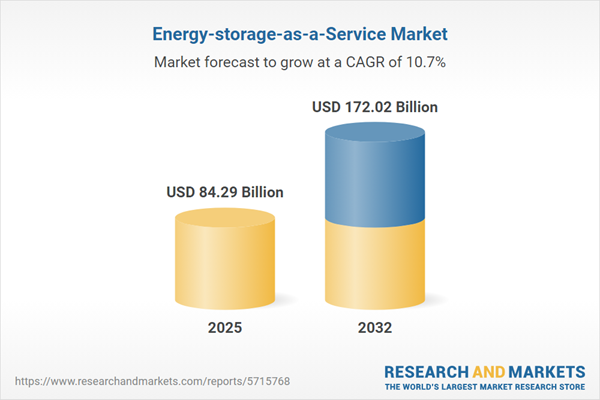Speak directly to the analyst to clarify any post sales queries you may have.
Energy-storage-as-a-service (ESaaS) is changing how organizations access and manage advanced storage solutions, providing flexible, reliable pathways to energy resilience without the need for major capital expenditure. By leveraging scalable, service-based models, senior leaders can more confidently align infrastructure investments with evolving operational needs and market conditions.
Market Snapshot: Energy-Storage-as-a-Service Market Trends
The global ESaaS market is experiencing consistent growth, supported by increasing demand for scalable and dependable energy solutions. In 2024, market valuation stands at USD 76.03 billion, reflecting a notable CAGR of 10.74% that projects expansion to USD 172.02 billion by 2032. Core catalysts include accelerated enterprise adoption, sharpened focus on grid stability, and an evolving regulatory landscape across significant economies. Executives value ESaaS for its ability to mitigate power supply risks, accommodate policy shifts, and navigate ongoing market complexity. As organizations prioritize business continuity, ESaaS has become an integral component in supporting critical infrastructure and preparing for fluctuating energy requirements worldwide.
Scope & Segmentation of the Energy-Storage-as-a-Service Market
- Service Offerings: Includes backup power, demand charge management, dynamic pricing response, frequency regulation, load shifting, and peak shaving to foster uninterrupted business operations and compliance with new frameworks.
- Technology Options: Utilizes advanced batteries, such as lithium iron phosphate, flow batteries, nickel manganese cobalt, lead acid, and sodium ion, allowing tailored improvements in sustainability and operational effectiveness.
- Application Areas: Enables infrastructure protection, rapid power recovery, renewable integration, and grid reliability to enhance comprehensive energy strategies and drive optimization objectives.
- End Users: Adopts commercial and industrial players, residential developers, telecom organizations, and utilities, all seeking greater performance, redundancy, and stability in diverse settings.
- Deployment Modes: Supports both on-grid and off-grid installations, demonstrating adaptability from densely populated urban sites to remote, harder-to-access environments where streamlined setup is vital.
- Regions: Different trends emerge in the Americas, Europe, Middle East and Africa, and Asia-Pacific, shaped by varying policies, infrastructure readiness, and investment direction in each region.
- Leading Companies: Key market players include Fluence Energy, Tesla, AES Corporation, Wärtsilä, Siemens Energy, ABB Ltd, Enel X, ENGIE, NEC Energy Solutions, and Stem, Inc., each providing innovative integration, customization, and end-to-end service solutions.
Key Takeaways for Strategic Decision-Making
- Service-based energy storage allows organizations to synchronize energy solution investments with broader business priorities, optimizing operational and capital resources.
- Ongoing advances in battery chemistry and intelligent control tools help organizations streamline workflows and adapt more effectively to regulatory developments.
- Integrating ESaaS with grid systems opens access to new demand response initiatives, enabling more dynamic peak load management and reducing operational risk from market volatility.
- Tailored service models and vertical integration provide flexibility for scaling site operations and reinforce energy infrastructure resilience across multiple locations.
- Engagement with infrastructure and financial specialists builds stronger risk mitigation and diversified procurement strategies, ensuring responsiveness as the energy landscape evolves.
Tariff Impact and Strategic Supply Chain Response
The upcoming U.S. tariffs in 2025 are prompting companies to reassess supplier relationships and enhance local manufacturing. By investing in domestic supply chains, organizations seek to reduce risk exposure and establish more dependable procurement processes to ensure operational stability as the ESaaS market develops.
Methodology & Data Sources
This analysis is based on primary research, including executive interviews and regulatory studies, and is corroborated by reliable secondary sources. Insights from experienced industry and business leaders contribute practical, actionable intelligence tailored for senior decision-makers.
Why This Report Matters
- Enables senior leaders to accelerate ESaaS implementation, driving energy resilience and operational efficiency.
- Delivers segmentation detail and regional perspectives to assist organizations in strengthening supply chains and planning for uncertain conditions.
- Supports effective benchmarking, empowering teams to make strategic choices that align with changing market environments and performance goals.
Conclusion
Energy-storage-as-a-service equips organizations to tackle changing energy challenges with agility and control. Strategic adoption supports reliable operations, improved scalability, and preparedness for ongoing industry transformation.
Additional Product Information:
- Purchase of this report includes 1 year online access with quarterly updates.
- This report can be updated on request. Please contact our Customer Experience team using the Ask a Question widget on our website.
Table of Contents
3. Executive Summary
4. Market Overview
7. Cumulative Impact of Artificial Intelligence 2025
Companies Mentioned
The companies profiled in this Energy-storage-as-a-Service market report include:- Fluence Energy, LLC
- Tesla, Inc.
- AES Corporation
- Wärtsilä Corporation
- Siemens Energy AG
- ABB Ltd
- Enel X S.r.l.
- ENGIE SA
- NEC Energy Solutions, Inc.
- Stem, Inc.
Table Information
| Report Attribute | Details |
|---|---|
| No. of Pages | 182 |
| Published | November 2025 |
| Forecast Period | 2025 - 2032 |
| Estimated Market Value ( USD | $ 84.29 Billion |
| Forecasted Market Value ( USD | $ 172.02 Billion |
| Compound Annual Growth Rate | 10.7% |
| Regions Covered | Global |
| No. of Companies Mentioned | 11 |









